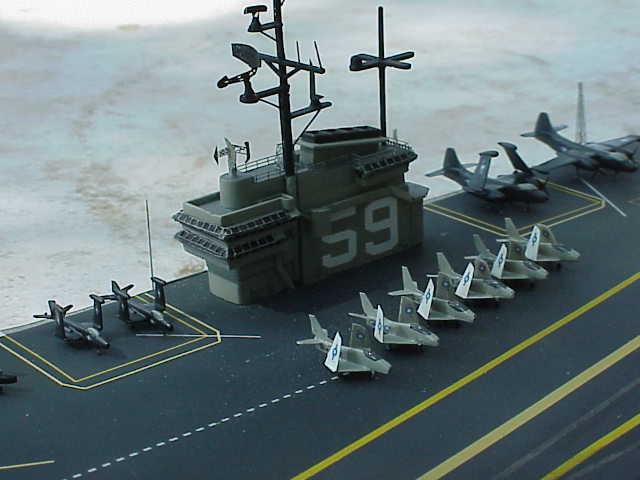|

The USS
Forrestal was commissioned in 1956 as the first of the supercarriers.
She was the largest warship built in her time, and was the prototype for
the American carrier design plans of the future, and influences the
ships of today.
My model is the Italieri kit somewhat modified to backdate it to 1956.
Let me walk you
through the major reconstruction. Using the Detail and Scale book of the ship
was invaluable for research purposes.
Hull: The hull was not too bad, and I left it as a waterline kit, as
that’s what the rest of my collection is. I needed to add the fore gun sponsons,
and after conversing with another modeler, Marc Johnston of California, he sent
me resin castings of his sponsons (he was doing the same project, and we
compared notes on several things- Thanks, Mark!!). I faired the sponsons on to
the hull after carefully measuring their placement, then puttied the seems.
Added detail on those was limited to the catwalks and gun decks. I also had to
modify both aft sponsons and add the catwalks and gun decks. Some other smaller
hullside decks were added based on historical data (line drawings and photos). I
also added the hullside fuel lines with plastic rod.
Flight deck: I had to remove a small extension at the waist cat extreme
port side of the deck to straighten it out from the portside elevator astern. I
removed the molded on arrestor cables. I filled the trenches in the deck
representing the catapults and JBD’s.
Island: This took the most time and effort. I rebuilt much of the island-
the bridge and prifly windows were all replaced with angled ones made of angled
plastic and photoetched bridge window sections from GMM frets. I also rebuilt
the funnel to reflect the slanted one Forrestal had in her early years before it
was flattened. I had to rebuild the entire port side to reflect the mast trough
originally built in. Her mast could be laid onto the flight deck to clear low
bridges and obstructions, and it was hinged at the flight deck. The mast was
housed in a trough of sorts that went up the port side of the island.
Markings: I love the USN carrier markings of the early to mid 1950s-
cavalry yellow markings which were not always very visible as compared to white,
but certainly different. I had to cut the “59” on the bow and stern deck areas
by hand and apply them, along with researching the other yellow markings,
particularly the landing area. Carrier decks were often a mix of white and
yellow markings, and those are shown here. I ran out of some minor marking
material, like white dashed lines a safety zone parallel to the starboard of the
landing lines. Early photos show Forrestal’s deck to be a dark blue, similar to
the blue used on WWII ships. I used Testors Dark Sea Blue for the flight deck,
at the risk of being wrong. I weathered it slightly at the arrestor cable area
for realism.
Aircraft: Thanks to White Ensign Models, I can show my Forrestal with
period aircraft. In ’56, Forrestal conducted deck trials with a wide variety of
Naval aircraft, and one photo in Detail and Scale shows this to great advantage-
Furies, Banshees, Cutlasses, Skynights and Skyraiders all cohabitating the
flight deck. I added a couple of AJ-1 Savages for good measure. They were soon
replaced by A-3 Skywarriors.
The ‘50’s were an exciting era in Naval aviation- Big defense budgets to
counter the menace of the Red Threat. The politics of defense budgeting
resulted in contracts for weapons systems that did not always perform as
planned. Often carrier aircraft were obsolete soon after they reached
the fleet due to the speed at which technology was developing, and they
were quickly relegated to the reserve units as the newer, hotter planes
graced the big ships. I chose to show a combination of blue, grey and
natural metal birds. Not only was that period famous for the rapid
change in technology, but also in ’56 the Navy announced a change in
paint schemes to the gull grey over white scheme. From ’56 through about
’58, it was not uncommon to see combinations of blue planes and grey
planes on flight decks across the fleet.
Hope you enjoy USS Forrestal, 1956!

Photos and text © 2005 by
Bob O' Connor
April 21, 2005
www.carrierbuilders.net |